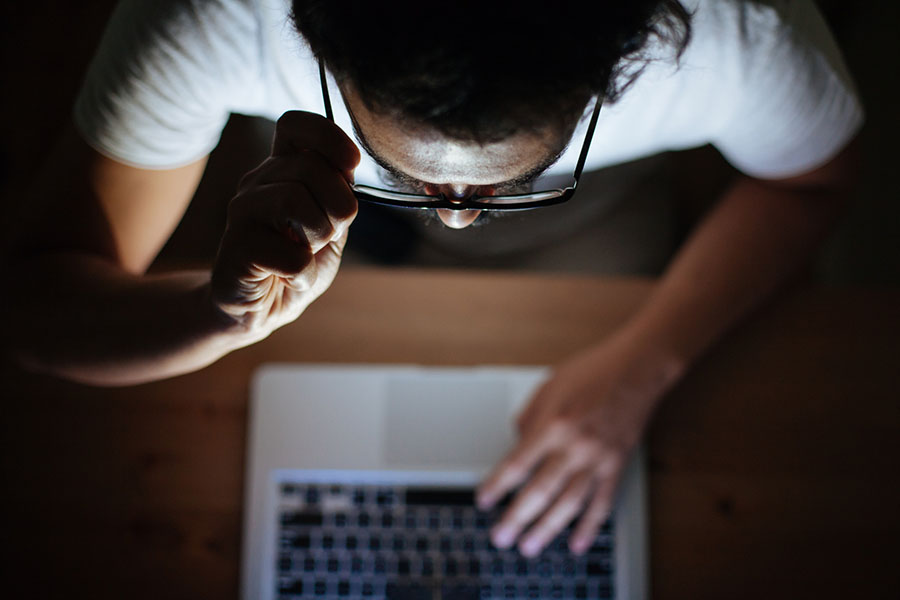The Mental Risks of Working and Learning in Isolation
Technology enables remote work while social distancing. A UK National Health Service (NHS) psychiatrist discusses how technology is redefining her work, people’s lives, and the risks we all face.

Key Points
- Mental health specialists are employing technology in new ways, even as they analyze its impact on people practicing social distancing around the world.
- Telehealth, telework, and tele-education underpin the response to COVID-19 public health crisis, but also present new mental health risks, including assaults on information privacy, security, and integrity via email phishing attacks, misinformation, and other means.
Use of telehealth, telework, and tele-education skyrocketed globally in recent weeks as social distancing has become a way of life in the wake of the coronavirus pandemic. Tania Saour, a psychiatrist with the U.K.’s National Health Service (NHS), is on the front lines of this dramatic shift. She now works with patients remotely. And more of her analysis focuses on the mental health impact of living increasingly isolated and online. Her perspective—along with findings from other experts in healthcare, technology, and society—provide early insights about the technologies people are using as they “shelter in place.” Among them:
- Mental health has become an increasing concern amid isolation, uncertainty, and growing internet use.
- Telehealth is an invaluable tool, but its limitations are showing.
- Working and learning at home are exposing adults and children to a rising “infodemic” of misinformation, including “fake news” and email scams.
Uncertainty Provokes Anxiety
“This is such an uncertain, unpredictable time that we’re all very likely to be seeing some sort of change to our mental state—particularly an increase in anxiety levels and changes in mood,” said Dr. Saour. “And the risk is likely to increase with time.”
Research published by the U.S. Centers for Disease Control and Prevention (CDC)[1] has found similarities with past pandemics in people’s early reactions to coronavirus. “As during the 2003 SARS and 2014 Ebola virus disease outbreaks, generalized fear and fear-induced overreactive behavior were common among the public,” the paper said. Psychiatric disorders such as depression, anxiety, and post-traumatic stress disorder have also increased.
Making matters worse, the world is experiencing an “infodemic,” or overabundance of misinformation on social media, the CDC paper said. Incidences have ranged from biased news on coronavirus to what Mimecast Global Threat Intelligence has reported as a surge in cyber criminals’ fear-mongering email scams targeted at the millions of adults and children now working and learning at home.
Some see mental health impacts outlasting some of the more direct effects of the pandemic, The Guardian reported. People could suffer enduring fear of contact with others, aversion to public spaces, panic attacks, addiction, obsessive-compulsive disorders, and stress-related illnesses.[2]
Governments from China to Italy to the U.K. and U.S. have issued mental health guidelines and have integrated psychological crisis interventions into their public health response. They’ve taken steps such as opening hotlines, extending insurance to cover telehealth, and lifting privacy restrictions on doctor-patient use of smartphone apps, messaging, and video.
Telehealth Fills Gaps
Dr. Saour has been handling a heavy schedule of video calls with patients in her practice with children and adolescents. “This is something not many people are used to, and we have had to adapt very quickly to enable efficient and continued care to our patients,” she said.
She has found video calling invaluable. “It plays an extremely important role in enabling us to continue monitoring patients’ mental states and medication.” Yet there are shortcomings. “Face-to-face contact within psychiatry has invaluable benefit,” she said. Assessment and doctor-patient rapport depend on factors like eye contact and facial expression, which she finds harder to read during a video call.
Besides, she noted, systems fail. For example, mishandled apps or lost internet connections can lead to missed appointments.
Breach of patient privacy is another potential downside. Across the world, even as governments encourage telehealth applications, hacks have been reported in apps commonly used for video calls with patients. “Healthcare privacy is paramount to our daily working,” Dr. Saour said. “It is important to inform patients that there are risks using telehealth, but that we do everything we can to minimize this risk.”
Telework Explodes
Over one third of Americans surveyed in April by the Massachusetts Institute of Technology (MIT) reported that they had recently stopped going to the office and now work at home. “Combined with the roughly 15% who said they’d been working from home pre-COVID-19, that means nearly half the U.S. workforce might now be remote workers,” the survey said.[3]
In the U.K., Dr. Saour said conferencing has helped healthcare teams stay in contact, lifting morale and keeping communications flowing. In fact, “from my experience I feel it has brought colleagues closer together,” she said. “With multiple people joining meetings, we have the opportunity to discuss certain issues or concerns with a larger number of individuals—receiving ideas and advice from more sources.”
Yet a downside of telework, for many adults, is the tendency while online to constantly check on the latest coronavirus reports. “Spending too much time on the internet—reading or watching the news continuously—will lead to higher levels of stress and anxiety,” she said. “It can also impact their sleep, making it hard for them to switch off and settle.”
Hackers are feeding on this anxiety, adjusting their tactics to home in on users’ latest fears and shifts in online behavior. A growing example: coronavirus-related email phishing attacks to capture people’s credentials, which are then used to disrupt video calls or to participate silently, capturing confidential information.
Victims of such email scams and similar exploits tend to suffer from stress, trust issues, energy loss, and other emotional, physical, and psychological impacts, according to a survey by the Identity Theft Resource Center.[4] As for misinformation and information overload, one therapist has written of “headline stress disorder,” in which people develop a sense of foreboding, mistrust, and loss of control.[5]
Tele-Education Delivers Mixed Results
If navigating the best and worst of the internet is challenging for adults, it is even more so for children and adolescents.
“With everyone from preschoolers to doctoral candidates suddenly forced to stay home due to the coronavirus pandemic, the global sector of online learning and educational technology is facing the biggest opportunity – and biggest test – of its existence,” according to a report in U.S. News and World Report. “Around the world, results have been mixed.”[6]
And as young people spend more time at home and online, they are subject to many of the same cybercrime and information risks as their parents. As they become more vulnerable to receiving scam emails and fake news articles, Dr. Saour said, they have a hard time differentiating between what’s real and what’s fake.
In a poll, 66% of young people already struggling with their mental health said they found reading or watching the news while social distancing to be “unhelpful.”[7]
The Bottom Line
People have come under enormous stress while social distancing, including from the technologies that enable them to work and learn at home. Recommendations from such authorities as the World Health Organization[8] to psychiatrists now treating their patients online and to technologists battling new waves of cybercrime strike some consistent themes:
- People need to be aware of the risks.
- They should limit news consumption, for instance, to two specific times during the day.
- Everyone should develop more critical thinking about the messages coming into their social media and news feeds, and the potential email scams coming into their inboxes.
- Parents should encourage open communications with their children, while reminding them that everything they read online is not necessarily true.
[1] “Public Mental Health Crisis during COVIDl-19 Pandemic, China,” Centers for Disease Control and Prevention
[2] “Anxiety on Rise Due to Coronavirus, Say Mental Health Charities,” The Guardian
[3] “COVID-19 and Remote Work: An Early Look at U.S. Data,” Massachusetts Institute of Technology
[4] “New Study by Identity Theft Resource Center Explores the Non-Economic Negative Impacts Caused by Identity Theft,” Identity Theft Resource Center
[5] “Overcoming Headline Stress Disorder,” Psychology Today
[6] “Countries Face an Online Education Learning Curve,” U.S. News & World Report
[7] “Coronavirus: Impact on Young People with Mental Health Needs,” YoungMinds
[8] “Mental Health and Psychosocial Considerations During the COVID-19 Outbreak,” World Health Organization
Subscribe to Cyber Resilience Insights for more articles like these
Get all the latest news and cybersecurity industry analysis delivered right to your inbox
Sign up successful
Thank you for signing up to receive updates from our blog
We will be in touch!

